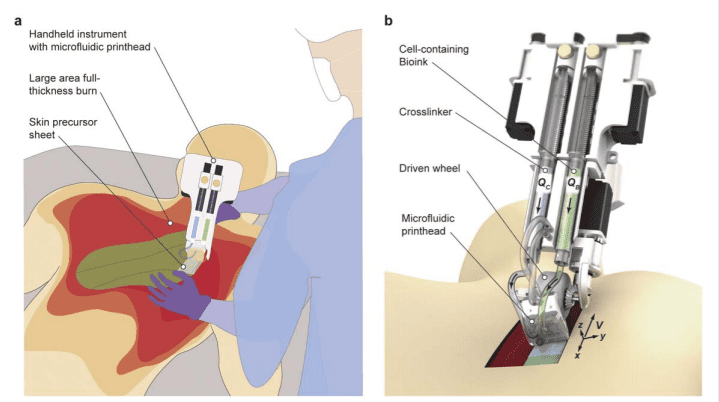Researchers from the University of Toronto (UoT) Engineering and Sunnybrook Hospital, Canada, have developed a new 3D printer that can create sheets of skin to cover large burns and accelerate the healing process.

Image credits Richard Y Cheng et al., (2020), Biofab.
Nobody likes to get burned — literally and figuratively. So a team of Canadian researchers has developed a handy new tool to take care of our literal burns. This hand-held 3D printer churns out stripes of biomaterial meant to cover burn wounds, promote healing, and reduce scarring. The bio-ink it uses is based on mesenchymal stromal cells (MSCs), a type of stem cell that differentiates into specialized roles depending on their environment.
Don’t feel the burn
“Previously, we proved that we could deposit cells onto a burn, but there wasn’t any proof that there were any wound-healing benefits — now we’ve demonstrated that,” says Axel Guenther, an Associate Professor of Mechanical Engineering at the UoT and the study’s corresponding author.
The team unveiled their first prototype of the printer in 2018. It was quite the novel gadget at the time, the first of its kind to form tissues on-site, deposit them, and have them set in place in under two minutes.
Since then, the team has redesigned the printer 10 times, in an effort to make it more user-friendly and to tailor it to the requirements of an operating room. The current iteration of the design includes a single-use microfluidic printhead (to ensure the part is always sterile), and a soft wheel that’s used to flatten the material and tailor it to wounds of different shapes and sizes.
The MSCs in the ink are intended to promote regeneration and reduce scarring, the team explains. In broad lines, the authors explain, the method is similar to skin grafting, but it doesn’t require for healthy skin to be transplanted from other areas of the patient’s body — it’s printed on the spot. This is especially useful in the case of large burns, they add.
“With big burns, you don’t have sufficient healthy skin available, which could lead to patient deaths,” says Dr. Marc Jeschke, director of the Ross Tilley Burn Centre and study co-author.
The team tested their printer in collaboration with the Ross Tilley Burn Centre and the Sunnybrook Hospital, successfully using the device to treat full-thickness wounds. Such burn wounds involve the destruction of both layers of the skin and often cover a significant portion of the body. While the results were encouraging, the team wants to further refine their printer and improve its ability to prevent scarring.
“Our main focus moving forward will be on the in-vivo side,” explains study leader Richard Cheng, a teaching assistant at the UoT.
“Once it’s used in an operating room, I think this printer will be a game changer in saving lives. With a device like this, it could change the entirety of how we practice burn and trauma care,” adds Jeschke.
The paper “Handheld instrument for wound-conformal delivery of skin precursor sheets improves healing in full-thickness burns” has been published in the journal Biofabrication.






